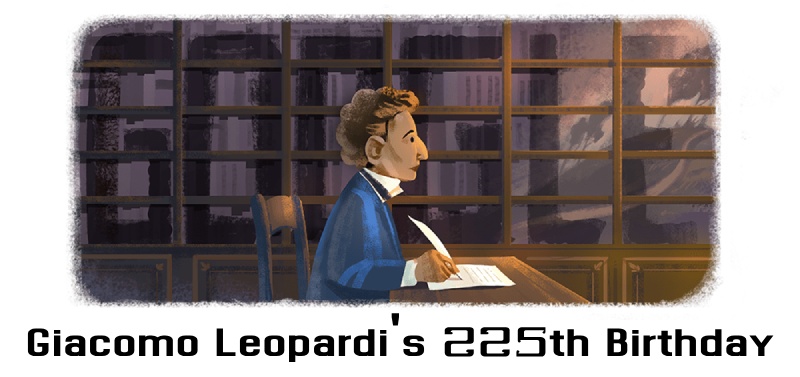Festivals & Events
Who was Giacomo Leopardi? Know Interesting Facts about an Italian Poet, Philosopher, and Scholar

Google Doodle is featured on June 29, 2023, to celebrate the 225th birthday of the Italian poet, philosopher, and scholar Giacomo Leopardi. He is regarded as one of the greatest Italian poets of the 19th century by the world. Here are some interesting and fun facts about Giacomo Leopardi.
Who was Giacomo Leopardi?
Quick Look
- Birth date: Giacomo Taldegardo Francesco di Sales Saverio Pietro Leopardi
- Birth date: 29 June 1798
- Birthplace: Recanati, Papal States
- Died on: 14 June 1837 (aged 38)
- Death place: Naples, Kingdom of the Two Sicilies
- Notable work:
- Canti
- Operette morali
- Zibaldone
- Era: 19th-century philosophy
- Region:
- Western philosophy
- Italian philosophy
- School: Classicism, later Enlightenment, Romanticism
- Main interests: Poetry, essay, dialogue
- Notable ideas: Philosophical pessimism
Interesting Facts about Giacomo Leopardi
Giacomo Leopardi was an Italian poet, scholar, and philosopher who was born on June 29, 1798, in Recanati, Papal States. His outstanding scholarly and philosophical works, as well as his superb lyric poetry, place him among the great writers of the 19th century.
Giacomo Leopardi was a son of Monaldo Leopardi, a minor count of a small village in Marches that was ruled by the papacy, and was born in Recanati, Italy. Giacomo’s mother was the Marquise Adelaide Antici. His father and a few priests served as his teachers as he was raised practically alone. The poet was greatly influenced by his father: He lost most of his wealth in failed businesses, so it’s possible that he didn’t have much practical sense. However, in 1812, he built an extravagant library that was open to the public.
Giacomo quickly exhausted his tutors’ resources as a precocious, congenitally deformed child of noble parents who appeared to be insensitive. He had independently learned Greek, Latin, and a few modern languages at the age of 16, translated a lot of classical works, written two tragedies, and a lot of Italian poems, and written several scholarly commentaries.
Giacomo Leopardi went to his father’s library and read a lot because of his father’s strict family manners, which made him feel even more alone. From the age of six, he was required to dress in black, just like his father. A kind of child prodigy, by the age of ten he no longer required tutors and when he was 17 he had mastered most areas of knowledge. Later, he described this dedication to study as “crazy and desperate.”
Nevertheless, it brought about extraordinary expertise in classical languages (he advanced something like seven languages, including Hebrew), and furthermore history, philosophy, philology, natural sciences, and astronomy. His asthma and scoliosis may have been caused by the long hours he spent studying in an unhealthy environment and reading by candlelight was blamed for his poor eyesight.
Excessive study permanently damaged his health: after bouts of poor vision, he eventually became blind in one eye and developed a cerebrospinal condition that afflicted him all his life. Forced to suspend his studies for long periods, wounded by his parents’ unconcern, and sustained only by happy relationships with his brother and sister, he poured out his hopes and his bitterness in poems such as Appressamento della morte (written 1816, published 1835, “Approach of Death”), visionary work in terza rima, imitative of Petrarch and Dante but written with considerable poetic skill and inspired by a genuine feeling of despair.
Giacomo Leopardi began his career as a translator, primarily of classical texts like Horace’s Ars Poetica in ottava rima. He also wrote a few minor treatises, like a History of Astronomy (1813) and an Essay on Popular Errors of the Ancients (1815), both of which are fascinating works that contain a lot of interesting facts and stories. Scherzi epigrammatici is a fictitious Greek poem that he also wrote.
In 1816, Giacomo Leopardi kept in touch with the Biblioteca Italiana (literary magazine), protecting the place of Italian classicists in reply to the renowned attestations of Madame de Stael about interpretations and scholastic verse. He is said to have moved “from erudition to beauty” at this point, from studying to writing poetry and other works of art. At this point, he gave up aseptic philology and the false taste of Arcadia in favor of a new neoclassical modern style.
At this time he began composing the Zibaldone, his gigantic collection of thoughts and verses and started his correspondence with Pietro Giordani. These letters demonstrate not only the young poet’s intellectual prowess but also the proportional severity of his mental issues, including his difficulty accepting and acting within the context in which he lived.
During a visit to the family at Recanati, he may have fallen in love with Gertrude Cassi, his married cousin. Nonetheless, Natalino Sapegno, one of the most important Italian literary critics, proposes that he created his Diario d’Amore while experiencing the discovery of romantic love, in the same way as other young people.
Leopardi lost any hope he had in 1817 and 1818 thanks to two events: his disappointed love for his married cousin, Gertrude Cassi (subject of his journal Diario d’amore and the elegy “Il primo amore”), and the death from consumption of Terese Fattorini, young daughter of his father’s coachman, subject of one of his greatest lyrics, “A Silvia.” The last lines of this poem express the agony he felt for his entire life: “O nature, nature, / Why dost thou not fulfill / Thy first fair promise? / Why dost thou deceive / Thy children so?”
Giacomo Leopardi’s internal suffering was eased up in 1818 by a visit from the scholar and patriot Pietro Giordani, who encouraged him to escape from his difficult circumstance at home. Finally, he went to Rome for a few difficult months in 1822 and 1823, and then he went back home for another difficult time, which was only brightened by the publication of his verse collection Canzoni in 1824. He accepted an invitation in 1825 to edit Cicero’s works in Milan.
Giacomo Leopardi published Versi (1826), an expanded collection of poems, while traveling between Bologna, Recanati, Pisa, and Florence for the following few years. furthermore, Operette morali (1827; ” Minor Moral Works”), a significant philosophical exposition of his doctrine of despair, primarily in the form of dialogue.
Lack of money forced him to inhabit Recanati (1828-30), yet he got away again to Florence through the financial help of companions and published a further collection of poems, I canti (1831). Disappointed love for a Florentine beauty, Fanny Targioni-Tozzetti, inspired some of his saddest lyrics. A young Neapolitan exile, Antonio Ranieri, became his companion and just solace.
Giacomo Leopardi attempted to flee his home in 1819, but his father learned his plan and stopped him. After temporary blindness caused him to stop reading, he wrote in his letters about his physical condition. Before long, he kept in touch with a portion of the Idilli, including L’Infinito and Alla Luna.
Also, he came up with his philosophical theory about pleasure (piacer, figlio d’affanno – pleasure is like worry, anguish, and hard work). His father let him go to Rome for a short time in 1822, but the poet was unhappy and couldn’t find a job that would fit him. He was before long back in the palazzo, having lost his confidence. The ornate celebrations of the Papacy’s temporal power that he had found in Rome were another disgusting element that prompted his return. Leopardi, on the other hand, was well-known and respected for his work before leaving Rome.
With the composition of his Operette Morali, Leopardi put into his works his saddest philosophical thoughts, and his historical pessimism (judiciousness as a reason for despondency) and his cosmic pessimism were delivered in their complex entirety.
Giacomo Leopardi finally left Recanati in 1825 and moved to Milan, where he began working for Fortunato Stella, an editor. Then he visited Bologna (pointlessly following the lady Teresa Malvezzi, who captivated him) and Florence, where he met Alessandro Manzoni (the other extraordinary Italian poet of the century), Viesseux, and Gioberti. He wrote A Silvia in Pisa.
In 1830 a few companions gave him a regular stipend, which permitted him to at long last fail to remember Recanati and secure himself in Florence. Here he fell in love (this time all the more genuinely) with Fanny Targioni Tozzetti (one more married woman), however, his love was pathetic. He met Antonio Ranieri, an exiled Neapolitan, in Florence. They later went to Naples, which his friend said would help him because of its warm climate.
In Naples, he found a genuine passion for ice cream, the warmth that Ranieri’s sister Paolina showed him (in the Ranieris’ villa Ferrigni on the slopes of Vesuvius), and the esteemed certainty of Basilio Puoti (the purista). A few months later, he died in Naples from edema.
Giacomo Leopardi moved to Rome, then, at that point, to Florence, lastly got comfortable Naples in 1833, where, among different works, he composed Ginestra (1836), a long poem remembered for Ranieri’s posthumous collection of his works (1845). The death that he had long viewed as the only liberation came to him out of nowhere in a cholera pandemic in Naples.
Poetry, which is admired for its brilliance, intensity, and effortless musicality, was Leopardi’s best outlet for his genius, hopelessness, and pain. Among his best poems are probably the lyrics in the early editions of his poetry that were referred to as “Idillii,” such as “A Silvia.”
One English translation of his exposition works is James Thomson’s Essays, Dialogues, and Thoughts (1905). R.C. Trevelyan’s Translations From Leopardi (1941) and J.-P. Barricelli’s Poems (1963) are two of the numerous translations of Leopardi’s poetry.
The Zibaldone, the Operette Morali (a collection of short stories), and the Canti collection of poems are among his most important works. He had a critical perspective of nature as a terrible mother generally very nearly obliterating humanity, while happiness came from the absence of pain (as expressed in La quiete dopo la tempesta where he says “piacer figlio d’affanno” (pleasure son of pain).
Unfortunately, Giacomo Leopardi was ill for the majority of his life and became increasingly blind. He was confined to Recanati for a considerable amount of time due to his medical conditions, but he was able to travel to Rome, Florence, Milan, Bologna, and Pisa throughout his lifetime. He died in Naples in 1837, probably from complications caused by edema.
Giacomo Leopardi wrote a manifesto, “Pompey in Egypt,” at the age of 14 that criticized one of Rome’s most powerful figures. He wrote notable poems like L’appressamento della morte (The Approach of Death), Inno a Nettuno (Hymn to Neptune), and Le rimembranze (Memories) in the years that followed.
Canti (Songs) and Canzoniere (Songbook), two of Giacomo Leopardi’s later works of lyric poetry, dominated his output for the rest of his career. His writing frequently explored patriotism, solitary love, and significant reflections on human life — making him a precursor to Existentialism. One of his final literary pieces was Operette morali (Small Moral Works), a collection of witty philosophical essays written in an unexpected style.
-

 Business3 weeks ago
Business3 weeks agoPrakash and Kamal Hinduja: Driving Social and Environmental Change
-
Education4 weeks ago
Fred DuVal: University Leadership as a Critical Resource for Climate Change Research and Life-Saving Solutions
-

 Health3 weeks ago
Health3 weeks agoThe Hinduja Brothers Commitment to Global Health: Empowering Communities Across Borders
-

 Cryptocurrency3 weeks ago
Cryptocurrency3 weeks agoDesigned For The Masses: How Akasha (AK1111) Is Unlocking Crypto For The Next Billion Users
-

 Cryptocurrency4 weeks ago
Cryptocurrency4 weeks agoNexaglobal & Future World Token (FWT): Could This Be the Next Big Crypto Investment of 2025?
-

 Sports4 weeks ago
Sports4 weeks agoWomen’s NCAA Tournament 2025 Sweet 16: Full Schedule, Fixtures, Teams, Bracket, and How to Watch March Madness Basketball Match Live
-

 Startup1 week ago
Startup1 week agoCost-Saving Strategies Every Small Business Owner Should Know to Boost Efficiency
-

 Startup3 weeks ago
Startup3 weeks agoMatthew Denegre on the Art of Deal Sourcing: Finding the Right Investment Opportunities























